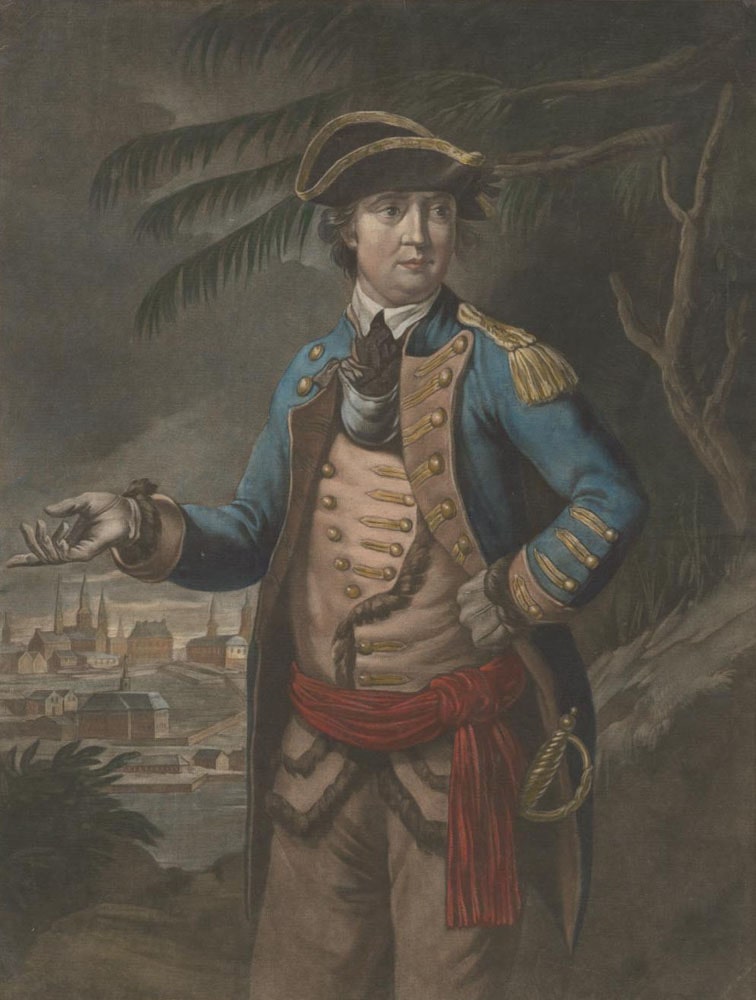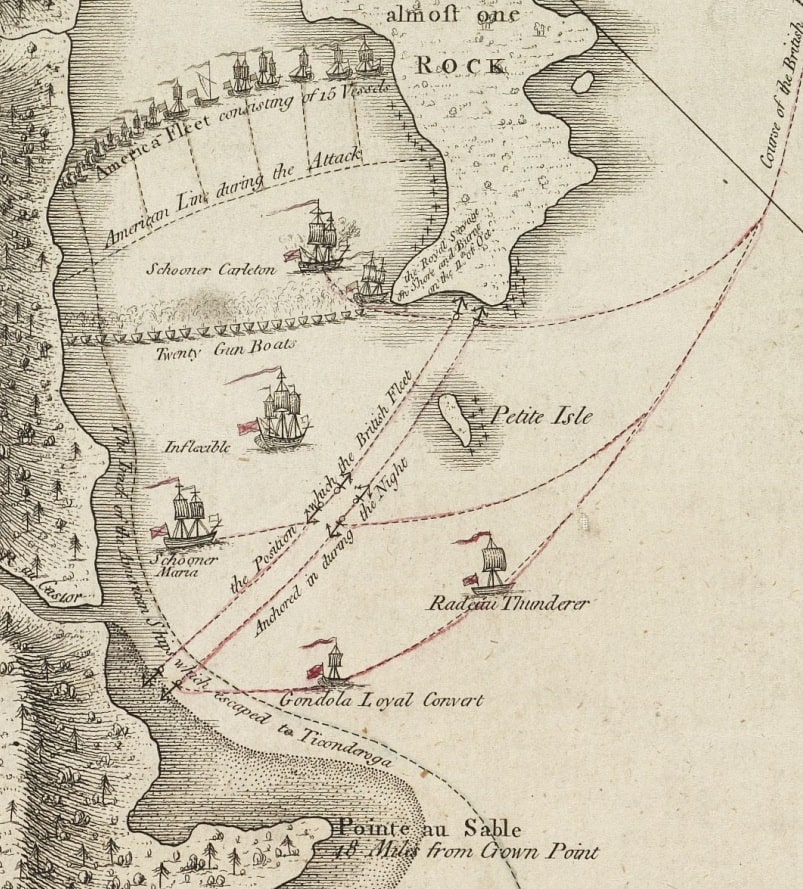Contents
Contents
The Battle of Valcour Island was fought between the British and Continental Navies on October 11, 1776, on Lake Champlain, along the borders of New York and Vermont.
This was the first major naval battle of the Revolutionary War, and was won by the British. However, the Americans succeeded in delaying the British advance towards the Hudson Valley until the following year, setting the stage for the Battles of Saratoga a year later.
Context
In September 1775, the Continental Army attempted to capture the British-controlled city of Quebec.
Quebec was seen as very strategically significant by the Continental Congress, and a large effort was undertaken to march north and capture the city.
The mission, led by General Richard Montgomery and Colonel Benedict Arnold, culminated in a decisive British victory at the Battle of Quebec on December 31, 1775.

Mezzotint. Published by Thomas Hart, London, 26 March 1776; coloring date unknown.
Suffering heavy losses, including the death of Montgomery, the American forces retreated south towards Fort Ticonderoga and Fort Crown Point on Lake Champlain.
Meanwhile, over the next six months, the British prepared to press their advantage, under the command of General Guy Carleton. They focused heavily on increasing the strength of their navy, with the plan to sail south and put pressure on Patriot positions in New York.
Controlling Lake Champlain would allow the British to divide the American positions in two, cutting off New England from the rest of the colonies by driving a wedge down the Hudson Valley.
The British worked to reinforce their navy by building prefabricated ships at St. Johns in Quebec, before moving them south and assembling the boats at Lake Champlain.
Now in charge of American forces after the Battle of Quebec, Arnold realized that his troops were outnumbered, outgunned, and running out of supplies.
The Continental Navy had far fewer shipbuilding resources compared to the British, and also suffered from a lack of materials, expertise, and manpower – though Arnold was a skilled shipbuilder.
The Colonel knew that his fleet would be defeated by the British in battle, but believed he could slow down their southern advance, preventing them from launching a full-scale invasion.
Therefore, he made a frantic effort to bolster the Continental Navy through a large shipbuilding effort at Skenesborough, New York.
Progress was slow to begin with, as the Americans worked to bring in shipbuilders from other parts of the colonies. Eventually, Arnold’s shipbuilding operation fully kicked into gear in the summer of 1776, and made impressive progress in a very short period of time.
The British sailed south from near Montreal on October 4, 1776. Meanwhile, Arnold set up his fleet on the west side of Valcour Island on Lake Champlain, to prepare to intercept their advance.
The battle
The British arrived at Lake Champlain on October 9, progressing slowly, in search of the American position.
By this point, the British fleet numbered:
- 1 sloop (Inflexible) – the main warship: largest ship on the lake, built for battle, carried the most cannons.
- 2 schooners (Carleton, Maria) – medium warships with two masts; quick and easy to handle; used for scouting and fighting.
- 1 radeau (Thunderer) – a large raft-like platform loaded with cannons; very slow; a floating gun battery.
- 1 gundalow (Loyal Convert) – a shallow, flat-bottomed barge for near-shore waters; hauled troops/supplies and a few guns.
- 28 gunboats – small oared boats, each with one heavy gun at the front; effective in tight, close-in fighting.
By contrast, the American fleet was made up of:
- 1 sloop (Enterprise)
- 3 schooners (Revenge, Liberty, Royal Savage)
- 4 row galleys – long, narrow boats with sails and many oars; could move even without wind; carried several cannons; used for both fighting and chasing.
- 8 gundalows
Thanks to its numerical advantage, the British fleet also enjoyed a significant upper hand when it came to the amount of firepower each side had.
On the morning of October 11, the Americans spotted the British near the north end of Valcour Island, and sent out Congress and Royal Savage to attract their attention.
The American boats were quickly overwhelmed by the strength of the British fleet, and quickly retreated, suffering heavy damage.
Initially, both sides had trouble positioning their ships for battle, due to strong winds on the Lake, but this changed at around midday, allowing the British ships to get in formation.
Fighting was fierce, with the British taking advantage of their superior fleet size and firepower. The USS Royal Savage was run aground and destroyed almost immediately.
However, the Americans put up a strong fight, inflicting heavy casualties on certain ships, including the HMS Carleton, which was almost destroyed before being towed away from the fighting.
Soon though, the British Inflexible arrived – their most powerful ship – and began inflicting heavy damage on the American fleet, forcing them to retreat to shallow waters, where the Inflexible could not follow.
As night fell, the British Navy positioned its ships in a line just south of the American position, preparing to destroy Arnold’s fleet when dawn broke.
Arnold realized that continuing to fight was hopeless, so he launched a daring escape plan.
Under the cover of darkness and a thick layer of fog, Arnold organized his ships into a single file and sailed through a small gap in the British line, using lanterns to light the way.
On the morning of the 12th, the British were shocked to see the Americans had escaped, and immediately gave chase south down Lake Champlain.
The Americans sailed as fast as they could, abandoning and scuttling damaged ships as they went. However, on October 13th, the wind turned against them, and the British caught up.
Ordering two smaller ships to hold up the British advance, Arnold ran aground his remaining fleet in what is now named Arnold’s Bay, a small, shallow inlet inaccessible to most of the British ships, two miles south of Buttonmold Bay, VT.
His men stripped the ships of guns and other valuables, and set them ablaze, before retreating towards Crown Point – a ruined but still strategic fort near Port Henry that served as a fallback position for the Americans.
In total, the Americans suffered 80 killed or wounded. 120 sailors were captured, and Arnold’s fleet was essentially completely destroyed.
On the other hand, the British suffered 40 men killed or wounded, and only one gunboat was destroyed.
Aftermath
Upon reaching Crown Point, Arnold determined that his men could not properly defend the position. They decided to destroy the fortifications, before retreating 15 miles further south to Fort Ticonderoga.
After the Americans escaped, General Carleton pressed south, quickly finding the remains of Crown Point.
From there, he sent out scouting parties in search of the Americans, coming to within a few miles of Ticonderoga.
However, after the first snowfall of the winter fell on October 20, Carleton decided that he could not continue, and returned to Canada to set up winter quarters.
Significance
The Battle of Valcour Island arguably saved the Americans from an early British victory in the Revolutionary War.
Without Arnold’s desperate efforts to delay the British advance, the Redcoats likely would have been able to successfully invade America from Canada in 1776, splitting colonial resistance in half from Lake Champlain down the Hudson River.
Instead, the British were forced to delay their campaign until the next year, where they attempted a three-pronged pincer movement during the Battles of Saratoga.
The second invasion attempt failed, leading to a significant British defeat, and turning the tide of the war in favor of the Americans.


